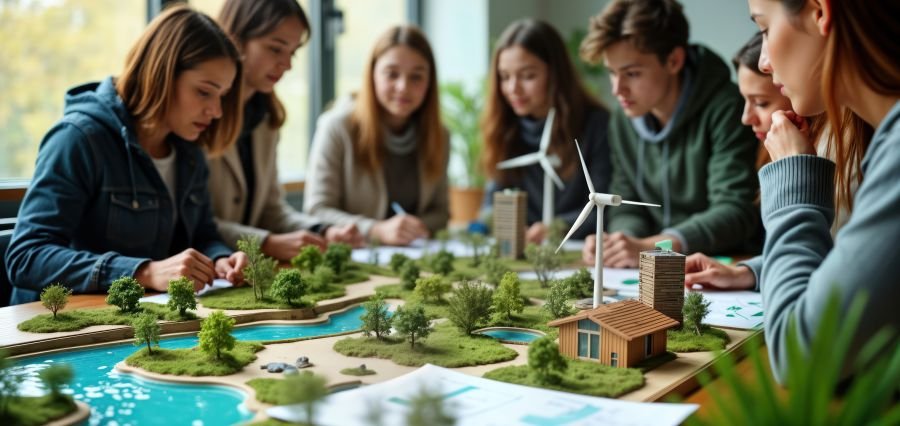The same world appeal to stop environmental destruction and global warming has witnessed green technology innovation flourish. Innovations are transforming industries, changing our lifestyle, and providing us with a greener tomorrow. This is a discussion on some of the most promising innovative new green technology and how perhaps it can save the environment from further imprint and bring a green revolution.
Understanding the modern developments in eco-friendly technology
- Developing Renewable Energy Technologies:
Solar, wind, and hydro renewable energy technology is primarily the driving force in green technology development. Significant improvement has been achieved, but efficiency and cost-effectiveness are yet to be developed with these technologies. Solar panel technology has improved energy conversion to make solar energy economically viable to be utilized in business and home uses. Likewise is the scenario with wind turbine technology, which, in terms of its efficiency and its high-powered turbines, can generate even more clean energy. Technology in the field of energy storage, for example, in the form of advanced battery systems, is also arresting the problem of intermittence of the renewable sources of energy.
- Green building products and construction:
The building sector is one of the largest producers of greenhouse gases. The green technology is transforming the way buildings are built by encouraging the use of green building materials and energy-efficient building. Green building materials like recycled wood, bamboo, and reclaimed wood minimize the environmental footprint of building construction. In addition, green buildings that utilize maximum daylight and natural light, have green roofs, and integrate smart building management systems are saving energy and promoting more green built environments.
- Green Transport Solutions:
The largest polluter is transport. Green technology is also behind green mobility choices such as electric vehicles (EVs), hybrids, and hydrogen fuel cell vehicles. Affordable and range-extended EVs are attracting increasing customers in electric mobility. Apart from that, battery advancements, charging, and seeking alternative fuel sources are cleaning and greening the transport industry.
- Intelligent Agriculture and Precision Farming:
Agriculture is vital to the sustenance of the world’s population, but it is destructive to the environment. Environmental technology is revolutionizing agricultural practice by implementing smart farming and precision farming techniques. The technologies use sensors, analytics, and automation to optimize the use of resources, save water, and minimize the use of fertilizers and pesticides. Precision farming enables farmers to make data-driven decisions, hence improving efficiency, reducing environmental degradation, and optimizing yield.
- Water Purification and Conservation Technologies:
With advanced waterborne purifying technology, desalination technology enabled by clean energy, and hi-tech irrigation methods, water scarcity is being brought under control and a pure supply of water is provided to every single member of planet earth. Access to clean drinking water is the birthright of people everywhere, whereas water scarcity has become an incomplete, infectious scenario globally. The natural world technology is quickly embracing its function in spreading new technologies for water-purifying and water-saving technologies.
- Waste Recycling and Management Innovations:
Efficient recycling and waste management are the pillars of circular economy growth for a sustainable future. Green technology is leading the waste management sector, e.g., innovative recycling technologies that have the potential to recycle difficult-to-treat wastes and recover valuable resources. New waste-to-energy technologies are also transforming waste into renewable energy, reducing landfill waste, and providing a clean source of energy.
- Green Chemistry and Sustainable Materials:
Green chemistry technologies are the answer to enjoying a cleaner, greener manufacturing sector. Green chemistry also attempts to create chemical products and processes that utilize no hazardous chemicals or, if unavoidable, minimize their usage to a significant degree. Clean technology is also prompting the creation of green materials like bio-plastics and biodegradable polymers which would substitute conventional plastics and avoid pollution.
- Carbon Capture and Storage Technologies:
Carbon capture and storage (CCS) technology seeks to capture industrial carbon dioxide emissions and keep them locked up underground, never to be seen again. Green technology is exerting pressure on CCS technology to be more affordable and efficient, which can be the magic bullet to avoiding climate change. While CCS is not a silver bullet solution, it could be an actual contribution to lowering greenhouse gas emissions from existing industrial infrastructure.
- The Convergence of Eco-Friendly Technologies:
The future of green technology can be imagined through the integration of multiple technologies and fields. Synergies between renewable energy systems and smart grids, data analytics and precision agriculture, and application of green building materials in creating smart cities are a few such instances of integrating and pairing different green technologies that can provide sustainable solutions. These synergies are significant in solving intricate environmental issues plaguing us today and creating a more sustainable tomorrow.
- Challenges and Opportunities in Eco-Friendly Technology:
While the eco-friendly technology revolution is a gift, there is a problem in its way. Cost factors, infrastructural weakness, and lack of policy interventions can make it unpopular on an enormous scale. Environmental awareness, consumer demand for green products, and government funding for green programmes are, nevertheless, opening wide doors for innovation and investment into the business of eco-friendly technology.
- The Investment and Policy Role in Stimulating Green Innovation:
Government initiatives such as carbon pricing, renewable portfolio standards, and tax credits for green technology innovation are significant enablers of innovation and diffusion of environmentally friendly technologies. R&D investment in the private sector as well as venture capital investment in green start-ups also have to be necessary to foster development and commercialization of new green technologies.
- Consumer Attitudes and Sustainable Behaviours:
Consumer behaviour is the key determinant of the success of green technology. Consumers can help build demand for green services and products through making informed choices and supporting environmentally conscious businesses. Educating consumers about the importance of green technology and encouraging eco-friendly consumption behaviours is important in establishing a market for green innovation.
- International Collaboration and Knowledge Sharing:
Conquering the global environmental issue requires global coordination and sharing of knowledge. Common R&D, coordination of environmental regulation, and exchange of best practices are indispensable to accelerating the process of converting to a more environmentally friendly world. Global alliances and collaboration are required to maximize the efficiency of environmentally friendly technology.
- The Future of Eco-Friendly Technology:
The prospects for green technology are bright. Ongoing innovation, along with friendly policies and increasing consumer awareness, will propel the creation and use of increasingly greener technologies. With the shift towards a progressively circular economy and low-carbon society, green technology will spearhead the movement towards a healthy world for generations to come. Ongoing innovation in this area promises and a way forward to a more sustainable and better-provided future for everyone.




